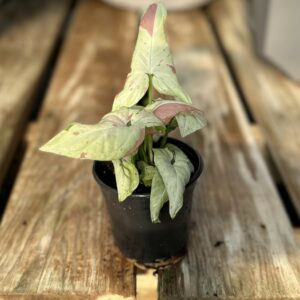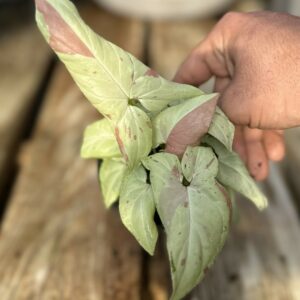-
You cannot add "Tradescantia 'Purple Zebra' 3"" to the cart because the product is out of stock.
Showing 65–69 of 69 results
-


$14.99
Syngonium ‘Pink Spot’ Care
Light: Provide bright, indirect light for your Syngonium ‘Pink Spot.’ It thrives in filtered sunlight or partial shade. Avoid exposing it to harsh, direct sunlight, as this can scorch the leaves.
Watering: Keep the soil consistently moist but not waterlogged. Water when the top inch of the soil feels slightly dry. Adjust the watering frequency based on environmental conditions, and be cautious not to overwater.
Soil: Plant your Syngonium ‘Pink Spot’ in well-draining, lightweight potting mix. A mix formulated for tropical plants or a combination of peat moss, perlite, and orchid bark works well. Ensure the pot has drainage holes.
Humidity: Syngoniums appreciate higher humidity levels. If your indoor environment is dry, consider misting the plant regularly or placing it on a tray filled with water and pebbles to increase local humidity.
Temperature: Maintain a warm environment for your Syngonium ‘Pink Spot.’ It prefers temperatures between 60°F to 75°F (15°C to 24°C). Protect it from drafts and sudden temperature fluctuations.
Fertilization: Feed your Syngonium ‘Pink Spot’ with a balanced liquid fertilizer every 4-6 weeks during the growing season (spring and summer). Reduce or eliminate fertilization in the fall and winter when the plant is not actively growing.
-


$12.99
Tillandsia cyanea ‘Pink Quill’ Care
Light: Provide bright, indirect sunlight for your Tillandsia ‘Pink Quill.’
Watering: Unlike some other air plants, Tillandsia cyanea ‘Pink Quill’ prefers to have its roots in a potting mix. Keep the soil consistently moist, but not waterlogged.
Humidity: Tillandsia ‘Pink Quill’ appreciates higher humidity levels.
Temperature: Maintain temperatures between 65-80°F (18-27°C).
Soil: Use a well-draining potting mix formulated for epiphytic bromeliads or a mixture of orchid bark, peat moss, and perlite.
Fertilization: Feed your Tillandsia ‘Pink Quill’ with a balanced, water-soluble fertilizer diluted to half strength. Apply the fertilizer every 4-6 weeks during the growing season (spring and summer).
-


$24.99
Vanilla planifolia ‘albo variegata’ Care
Light: Provide bright, indirect sunlight for your Vanilla planifolia ‘Albo Variegata.’
Temperature: Vanilla orchids thrive in warm temperatures. Keep the plant in temperatures between 65-80°F (18-27°C) during the day and no lower than 60°F (15°C) at night.
Humidity: Vanilla orchids prefer high humidity.
Watering: Keep the potting mix consistently moist but not waterlogged. Water when the top inch of the soil feels slightly dry.
Potting Mix: Use a well-draining, organic potting mix that retains some moisture.
Fertilization: Feed your Vanilla planifolia ‘Albo Variegata’ with a balanced, water-soluble fertilizer formulated for orchids. During the growing season (spring and summer), fertilize every 2-4 weeks. Reduce or stop fertilizing during the plant’s resting period.
-


$12.99
Venus Fly Trap Care
Light: Venus Fly Traps need bright, direct sunlight to thrive. They should receive at least 4-6 hours of direct sunlight each day. Place them in a south-facing window or under artificial grow lights. Inadequate light can weaken the plant.
Water: Use distilled or rainwater to water your Venus Fly Trap. Avoid tap water or bottled water with added minerals, as these can harm the plant. Keep the soil consistently moist but not waterlogged. Always keep the saucer underneath the pot filled with water to maintain the required humidity.
Humidity: Venus Fly Traps require high humidity levels. You can increase humidity by placing the pot on a tray filled with water, using a humidity tray, or misting the plant regularly. Avoid letting the soil dry out.
Soil: Plant your Venus Fly Trap in a mixture of sphagnum moss and perlite. This soil combination provides the necessary acidity and moisture retention the plant needs.
Feeding: Venus Fly Traps obtain essential nutrients from the insects they capture. While it’s not required to feed them, if your plant doesn’t catch enough insects naturally, you can provide small insects, such as live flies or ants, to stimulate growth. Do not feed it human food or inorganic materials.
Triggers: Avoid touching the sensitive trigger hairs inside the traps. Repeatedly triggering the traps without prey can exhaust the plant’s energy.
-


$14.99
Zamioculcas zamiifolia ‘Nova Star’ Care
Light: ZZ plants are adaptable and can tolerate a range of light conditions. ‘Nova Star’ prefers bright, indirect light but can also thrive in low-light conditions.
Watering: Allow the soil to dry out completely between waterings. ZZ plants are drought-tolerant and can handle being underwatered better than overwatered.
Soil: Use a well-draining potting mix formulated for succulents or cacti.
Temperature: Keep your ZZ plant ‘Nova Star’ in temperatures between 60-75°F (15-24°C).
Humidity: ZZ plants are adaptable to normal indoor humidity levels.
Fertilization: Feed your ZZ plant ‘Nova Star’ with a balanced, diluted, liquid fertilizer every 2-3 months during the growing season (spring and summer).










